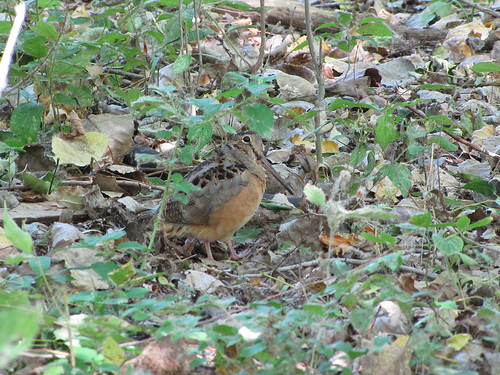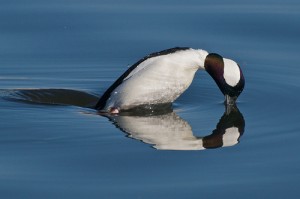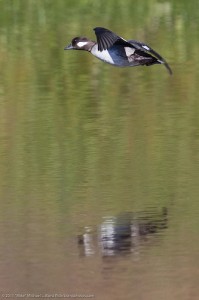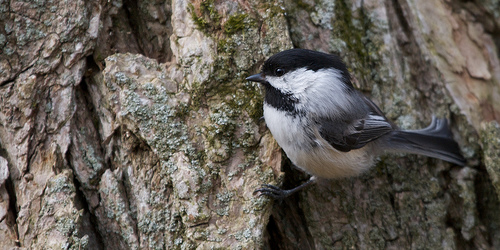All fall, we have watched birds flock to our sunflower seed feeder, our thistle feeder, and our suet containers. As I wrote last month, our feed store folks love us — we are going through a lot of bird food.
Where does all this food go? I know that some of our visitors are eating it on the spot but many seem to fly away with one or more seeds in their craw. Recall our discussion of Common Redpolls and their “pocket.”
It turns out that birds have three options to make it through the time when there is little food.
- They can “get out of Dodge” by migrating to places where there is food
- They can scratch and scrounge and nearly starve, or
- They can store food and hope it’s there when they need it.
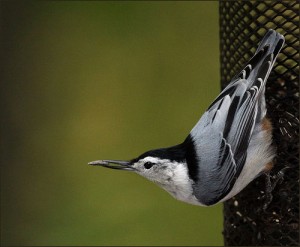
White-breasted Nuthatches and their red-breasted brethren also store food for later dining. I often see them nabbing a large seed and flying off.
Our most frequent visitors to the feeders are Black-capped chickadees which are well known for their food-hoarding behavior. Usually they hoard seeds but they are also known to store insects and spiders may be stored as well. I’ve seen hundreds of chickadees grab sunflower seeds and pieces of suet from bird feeders. They remove the husk of a seed before caching it. I’ve seen a few stashing seeds in the bark of our white pines.
The number of seeds stored is staggering. Over 1,000 items may be stored in a single day and, over the course of autumn, 50,000 to 80,000 seeds may be cached. Sites for food storage are varied. Typical hiding places are cracks or crevices in woody vegetation, under bits of bark (particularly birch bark), in clusters of conifer needles, in the ground and even in the snow.
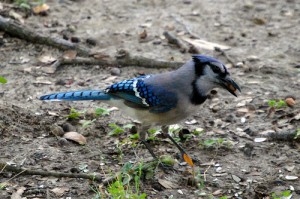
Other food hogs at the feeder are Blue Jays which are energetic hoarders, storing acorns and other nuts but even invertebrates, small vertebrates or bits of meat. Favored storage sites are cracks and crevices of tree trunks, amid the needles of conifers and in loose soil.
A blue jay can carry up to five acorns at once to be stored. The acorns are swallowed and stored in the upper part of the esophagus. The acorns can then be regurgitated intact when a suitable hoarding site is found.
Several Western birds are known for their hoarding. Pinon Jays and Clark’s Nutcrackers both rely heavily on hoarding to get through the winter. Both species store pine seeds, which they laboriously remove from pinecones. A single Clark’s nutcracker can store up to 100,000 seeds in the fall. Both nutcrackers and pinon jays do not raid their hoarded seeds until most of the fall seed crop is depleted. One researcher has determined that up to 90 percent of the winter diet of Pinon Jays comes from stored seeds.
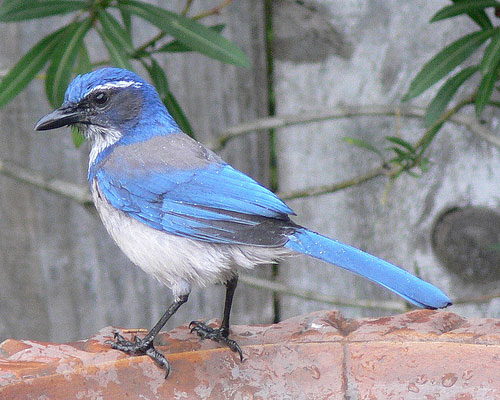
Western Scrub Jays take a lot of precautions with their food. When another jay is watching, a scrub jay will store food in difficult to see places (far from an observer, behind a visual barrier, etc.). Often, if observed while hiding food, later, when unobserved, it will move food to another location.
How does a long-term hoarder like Clark’s Nutcracker recover stored seeds when it needs them? Ornithologists at first thought that the food was stored only in certain kinds of areas, and that the birds rediscovered it by later foraging in the same areas. But research shows that individuals can recall where they have cached seeds. The birds remember where the seeds are in relation to certain landmarks, such as rocks. If the landmarks are moved, the areas the birds search are displaced an equivalent amount.
Out of all the species of woodpeckers, only 10 are known to hoard food. Our Downy Woodpeckers and Hairy Woodpeckers are among the ten but only infrequently store food.
As I noted before, Northern Shrikes store food in an interesting way. Small mammals or birds are killed and then impaled on a thorn or barbed wire fence for later consumption, hence the reason for calling these hoarders “butcher birds”.
As we head into serious winter conditions, it’s comforting to know that many of our prior visitors have stashed food away. in case our buddies are having a brain cramp and like us, forgetting where they put things, we’ll keep the feeders clean and full.
Have you observed a bird hoarding food? Tell us about it with a comment below. You should sign up by RSS feed or via email to have future articles sent to you. Thanks
White-breasted Nuthatch by Dawn Huczek
Blue Jay by Ingrid Taylar Western Scrub Jay by jessicafm
